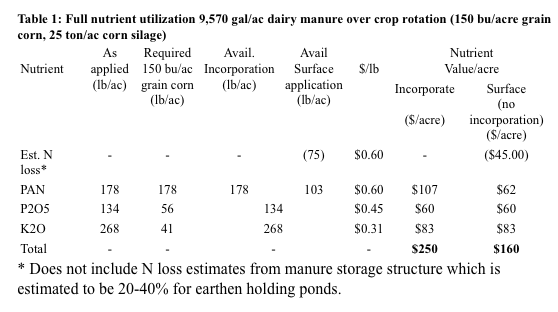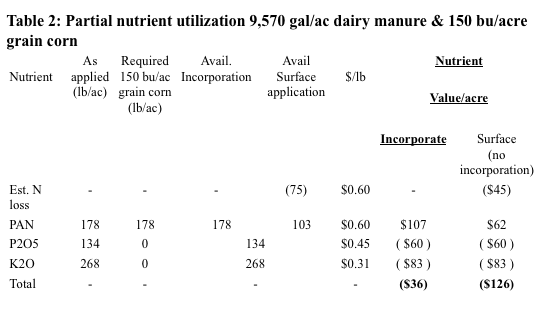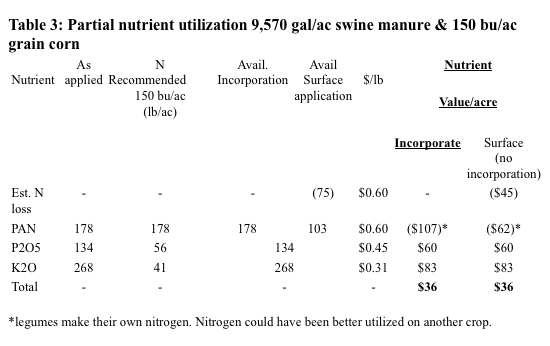(At the time this article was authored, fertilizer prices were lower than where they are presently. Present costs of fertilizer per pound of actual product are as of 3/25/08 approximately: N(UAN): $0.67 per lb., P2O5(MAP): $0.78 per lb., K2O(Potash): $0.46 per lb. This will translate into even higher nutrient values than what are listed in the following article.)
To maximize the nutrient value of dairy manure it must replace other nutrient inputs and be placed where a crop response is expected. The following examples place a value on liquid dairy manure within a corn-soybean-wheat rotation, and demonstrates how the value of manure depends upon the need for supplemental nutrients, manure handling and application practices. In these examples, the gross nutrient value of dairy manure ranges from $250 to ($126) per acre.
A manure test from this dairy facility indicates that 36 lbs of total nitrogen (TN), 16 lbs ammonia – nitrogen (NH4), 20 lbs organic-nitrogen (ON), 14 lbs of phosphorous (P2O5) and 28 lbs of potassium (K2O) are contained in 1,000 gallons. If the manure is injected below the soil surface in the spring, 19 lbs/1,000 gallons of the 36 lbs TN/1,000 gallons would be plant available nitrogen (PAN). On the other hand, if manure is spring surface applied without incorporation 75% of the NH4 -nitrogen could be lost, resulting in 11 lbs of PAN/1,000 gallons, a loss of nearly $7/1,000 gallons applied. The difference in PAN from manure and the estimated need of the crop can be supplied at planting as starter fertilizer.
Under ideal application conditions about $250/acre of dairy manure nutrients can be supplied from 9,570 gallons/acre of manure (Table 1). Ideal conditions include: (1) soil tests that indicate the addition of P2O5 and K2O will likely produce a yield response, (2) manure is injected evenly and uniformly and, (3) manure replaces other purchased nutrient inputs. In this situation, all of the nutrients in the manure are expected to be utilized by the growing crop over a corn, corn silage rotation. Under these conditions no additional P2O5 and K2O will likely be needed for the subsequent corn silage crop. Rather the nutrients supplied in excess will be held in the soil and drawn down by the subsequent crop. Although NH4 -nitrogen losses do not reflect a direct cash outlay, they do represent an opportunity where manure nutrients can be more fully utilized by minimizing these losses. Practices which capture more of the NH4 -nitrogen in manure will increase the value of this nutrient resource. Expected NH4 -nitrogen loss from surface applied manure are estimated to be $45/ac (Table 1). It is worth noting that ammonia-nitrogen easily volatilizes into the atmosphere from the time it is excreted through land application. Manure handling and storage practices which minimize volatilization of this resource will increase the nutrient value of manure and decrease the impact to the environment. Ammonia-nitrogen losses from earthen storage structures are estimated to range between 20% – 40%, or $5,467 to $14,580 at current market prices for nitrogen fertilizer ($0.60/lb).
When soil test results indicate P2O5 and K2O are above critical values (see Ohio State University , Tri-State Fertility Recommendations) additional nutrients will not result in a yield response, and the value of adding these nutrients is significantly diminished. Under these conditions only the PAN from manure can be utilized and the additions of P2O5 and K2O are not necessary and would be better utilized on other acres (Table 2). Nearly $143/acre of P2O5 and K2O are applied above agronomic recommendations and will not result in a yield response, representing a cost or a lost opportunity. The gross value of incorporated manure nutrients is expected to be ($36)/acre. When surface applied the volatilization of NH 4 -nitrogen reduces PAN and increases the opportunity cost of under utilizing N, P2O5 and K2O resulting in a loss of $126/acre. In addition, applying surplus nutrients may increase the risk of these nutrients being lost into the environment. Current input prices may afford those with excess soil nutrients to “draw-down” this balance by selling manure nutrients and purchasing only the nitrogen needs for the growing season.
In the final scenario (Table 3), dairy manure is applied following a legume crop where additional nitrogen is not recommended. In this case the nitrogen from manure is not fully utilized and has a lost opportunity cost of $107/acre, regardless of how manure is applied. In this situation the value of not applying manure where the nitrogen fraction is best utilized results in an opportunity cost of $16.56. Equally important is the nitrogen from manure is likely lost to the environment, negatively impacting those down stream.
In these examples the value of manure is determined by how this nutrient resource is managed within a cropping rotation. It is estimated that at least $250/ac of manure nutrients can be recycled when P2O5 and K2O contributions are matched to soil test nutrients, crop needs and when NH4 -nitrogen losses are minimized. When managed for only one nutrient, such as nitrogen, about $107/ac of the $250/ac is captured from the manure under typical conditions, but as much as $126/ac is forfeited when surface applied (Table 2). When manure is managed for only P2O5 and K2O about $36 of nutrients may be captured, but at least $107/acre of nitrogen may have been under utilized and/or lost to the environment.
The value of manure nutrients in these three scenarios is based upon how these nutrients are utilized by a growing crop. Applying this nutrient resource where additional nutrients are likely to produce a positive yield response will maximize the value of this resource. Adding nutrients above recommended critical levels will significantly decrease the value this resource and increases the potential of those nutrients being lost to the environment.
For some, brokering/bartering these nutrients may be more economical than hauling manure greater distances. When manure is treated like a nutrient resource, manure can be a cost-effective asset to the operation. Manure management does take time and the value of this resource can only be realized as it replaces commercial fertilizer or other purchased inputs.


